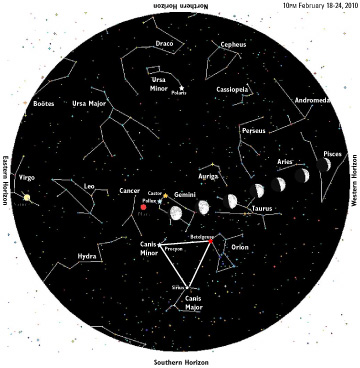Chesapeake Bay's Independent Newspaper ~ Since 1993
1629 Forest Drive, Annapolis, MD 21403 ~ 410-626-9888
Volume xviii, Issue 7 ~ February 18 - February 24, 2010
Home \\ Correspondence \\ from the Editor \\ Submit a Letter \\ Classifieds \\ Contact Us
Best of the Bay \\ Dining Guide \\ Home & Garden Guide \\ Archives \\ Distribution \\ Advertising![]()


Sky Watch

by J. Alex Knoll
The Night’s Brightest Lights
Careful not to scorch your eyes
As the sun sets this week after 5:45, two lights burn through its darkening wake above the southwest horizon. Venus and Jupiter, just a few degrees from one another, are the first and second brightest objects in the sky other than the sun and moon. Jupiter is on the last leg of its evening apparition, while Venus appears higher each passing night.
While Jupiter is more than 12 times larger than Venus, it is noticeably dimmer, shining at magnitude –2 compared to Venus shining at magnitude –4. But the light we see is not their own, rather sunlight reflected off the planets’ surface and back to us here on Earth. So while a ray of light travels only some 67 million miles to reach Venus, a ray of light travels more than 450 million miles from the sun before striking Jupiter’s surface. Then that sunlight has to bounce back to us.
Sunset reveals Mars high in the east, midway between the dim stars of Cancer and the bright twins of Gemini, golden Pollux and blue-white Castor. Blazing a fiery magnitude –1, Mars would be the brightest object visible through the night, were it not for Sirius in Canis Major far to the south.
Sirius, searing or scorching in Greek, shines at magnitude –1.4. It burns 25 times brighter than our sun, but that is only part of the reason why it appears so bright. At a mere 8.6 light years away, Sirius is the fifth nearest star to us.
If you couldn’t distinguish Sirius from its brightness alone, it is also the greatest twinkler. Never straying far above the horizon, the light from Sirius hits Earth at such an angle that it must travel through more atmosphere before reaching our eyes. Thus the light we see blinks and shimmies from all that interference.
Additionally, Sirius is a point of the great Winter Triangle, Orion’s red Betelgeuse and Canis Minor’s Procyon being the other two.
Illustration: © Copyright 1925 M.C. Escher/Cordon Art-Baarn-Holland; Graphics: © Copyright 2010 Pacific Publishers. Reprinted by permission from the Tidelog graphic almanac. Bound copies of the annual Tidelog for Chesapeake Bay are $14.95 ppd. from Pacific Publishers, Box 480, Bolinas, CA 94924. Phone 415-868-2909. Weather affects tides. This information is believed to be reliable but no guarantee of accuracy is made by Bay Weekly or Pacific Publishers. The actual layout of Tidelog differs from that used in Bay Weekly. Tidelog graphics are repositioned to reflect Bay Weekly’s distribution cycle.Tides are based on National Oceanic and Atmospheric Administration and are positioned to coincide with high and low tides of Tidelog.
© COPYRIGHT 2010 by New Bay Enterprises, Inc. All rights reserved.
